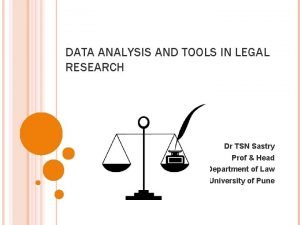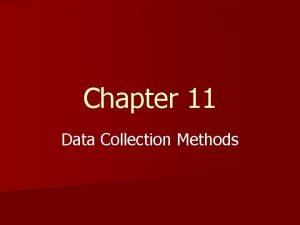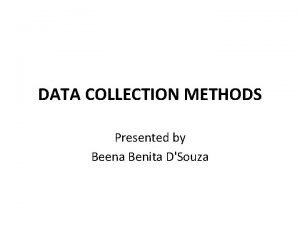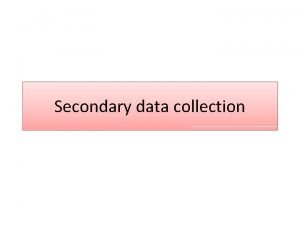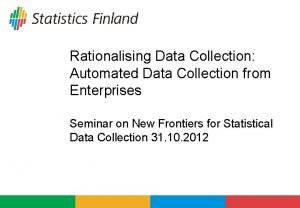Data Collection Methods Data Collection is an important





- Slides: 5

Data Collection Methods • Data Collection is an important aspect of any type of research study. Inaccurate data collection can impact the results of a study and ultimately lead to invalid results.

Quantitative and Qualitative Typical quantitative data gathering strategies include: • • Experiments/clinical trials. Observing and recording well-defined events (e. g. , counting the number of patients waiting in emergency at specified times of the day). Obtaining relevant data from management information systems. Administering surveys with closed-ended questions (e. g. , face-to face and telephone interviews, questionnaires etc).

Quantitative and Qualitative The qualitative methods most commonly used in evaluation can be classified in three broad categories: • indepth interview • observation methods • document review

Quantitative and Qualitative Quantitative research is concerned with testing hypotheses derived from theory and/or being able to estimate the size of a phenomenon of interest. Depending on the research question, participants may be randomly assigned to different treatments. If this is not feasible, the researcher may collect data on participant and situational characteristics in order to statistically control for their influence on the dependent, or outcome, variable. If the intent is to generalize from the research participants to a larger population, the researcher will employ probability sampling to select participants.

Quantitative and Qualitative data methods are characterized by the following attributes: 1. they tend to be open-ended and have less structured protocols (i. e. , researchers may change the data collection strategy by adding, refining, or dropping techniques or informants) 2. they rely more heavily on interactive interviews; respondents may be interviewed several times to follow up on a particular issue, clarify concepts or check the reliability of data. 3. they use triangulation to increase the credibility of their findings (i. e. , researchers rely on multiple data collection methods to check the authenticity of their results) 4. generally their findings are not generalizable to any specific population, rather each case study produces a single piece of evidence that can be used to seek general patterns among different studies of the same issue.

